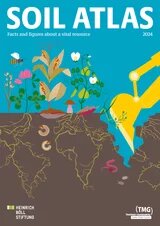
Soil degradation is a major but largely neglected global problem that threatens agricultural productivity, food security, and ecosystem health. Around one-third of soils worldwide are degraded, with over 40 percent located in Africa.

The extent and severity of soil degradation are influenced by both natural processes and human activities, such as deforestation, farming practices, overgrazing, and urbanisation. Key forms of soil degradation include erosion, salinisation, acidification, compaction, nutrient depletion, and contamination by heavy metals.
Erosion, primarily caused by water and wind, is one of the most widespread and severe forms of soil degradation. It carries away the nutrient-rich topsoil that is essential for plant growth. Soil erosion leads to the loss of an estimated 75 billion tonnes of soil a year, which in turn causes financial losses of around 400 billion US dollars annually. These alarming statistics underscore the profound economic and ecological consequences of soil degradation on a global scale.
Another critical problem is salinisation: the accumulation of salts in soil. This often results from improper irrigation practices. When irrigation water containing salts evaporates, it leaves the salt behind in the soil, which can accumulate to levels that harm plant growth. A significant portion of irrigated lands globally are affected by salinity, with some estimates suggesting that from 20 to as much as 50 percent are impacted, particularly in arid and semi-arid regions. In northern India, soil salinity is particularly severe and impairs wheat and rice yields.
Acid rain, excessive nitrogen-fertiliser use, and intensive agricultural practices are all primary causes of soil acidification. This is increasingly common in Asia, Europe, and North America, where industrial emissions of sulphur dioxide and nitrogen oxides react with water vapour in the atmosphere. In Europe, soil acidification – exacerbated by the inefficient use of nitrogen fertiliser – is diminishing crop yields, necessitating costly lime applications to temporarily alleviate the resulting acidity.
Compaction occurs when soil particles are pressed together, reducing the pore spaces between them and decreasing aeration and water infiltration in the soil. Compaction is often caused by heavy machinery and intensive livestock grazing. It cuts yields and makes crops more vulnerable to drought, as compacted soil hold less water.
Soil contamination by heavy metals, pesticides, and industrial chemicals, poses risks to plants, animals, and humans. It arises from industrial activities, improper waste disposal, the excessive use of agrochemicals – and even warfare. The ongoing Russia’s war of aggression against Ukraine has contaminated one-third of the agricultural land, while the use of white phosphorus bombs has poisoned farmland in southern Lebanon.
Soil degradation leads to nutrient depletion and a decline in soil biodiversity, damaging microorganisms that are essential for breaking down organic matter, recycling nutrients, and maintaining soil health and fertility for sustainable plant growth. This hinders processes such as nitrogen fixation and phosphorus solubilisation, resulting in nutrient-poor soils and lower crops yields. Moreover, healthy soil microbiomes protect plants from diseases. These vital soil functions are disrupted by soil degradation, increasing plants’ susceptibility to diseases.
Globally, around 18.1 million square kilometres of land are degraded. Some 62 percent of this area is damaged by unsustainable practices, such as improper agricultural methods, deforestation, and poor land management, while 38 percent is subject to overgrazing that exceeds the land’s capacity to recover and maintain its productivity.
In Sub-Saharan Africa, soil erosion can reach up to 100 tonnes per hectare annually, reducing crop yields by 30 to 50 percent in severely affected areas. Approximately 65 percent of arable land in the region is now classified as moderately to severely degraded, posing a significant threat to food security. In Europe, 61 percent of soils are currently unhealthy, primarily due to organic carbon loss, biodiversity loss, and peatland deterioration. Due to gaps in data on soil contamination, the overall extent of degradation is likely to be even more severe. In South Asia, soil degradation is driven by the cultivation of steep lands, excessive ploughing, flood irrigation, removing or burning crop residues, unbalanced fertiliser use, and uncontrolled grazing.
These practices reduce crop growth and yields. Moreover, irrigated lands suffer from salinisation and groundwater depletion. Land degradation costs South Asia an estimated 10 billion US dollars annually.
Concerted efforts that address the drivers of soil degradation are needed. The fight against soil degradation is a battle for the very foundation of life on Earth.


